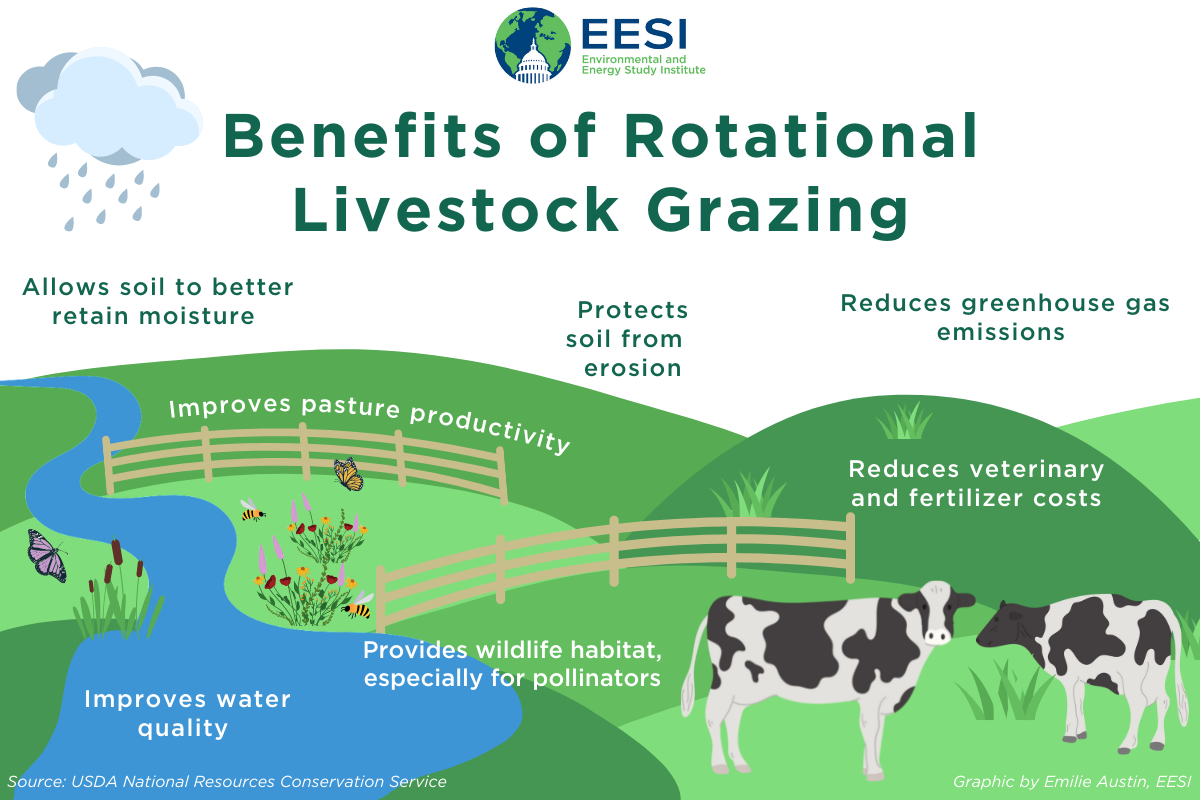Managed Grazing
Managed grazing is a sustainable livestock management practice that can improve soil health, increase carbon sequestration, and contribute to climate change mitigation while maintaining agricultural productivity.

Benefits of management rotational grazing (Environmental and Energy Study Institute)
job openings
View open jobs in this Solution
Example Companies
- Savory Institute - Promotes holistic management and regenerative agriculture practices.
- PastureMap - Provides software for grazing management and land monitoring.
- Grassroots Carbon - Connects ranchers practicing regenerative grazing with carbon credit buyers.
- Sustainable Grazing Systems - Offers consulting and education on regenerative grazing practices.
- MaiaGrazing - Develops grazing management software for livestock producers.
Overview
Managed grazing has made significant progress in recent years as a tool for reversing climate change. Key advancements include:
- Grazing management software for more accurate monitoring and management of herds.
- GPS-based grazing management systems for tracking herd movements.
- Remote sensing systems for improved grazing pattern analysis.
Progress Made
Recent advancements in managed grazing include:
- Satellite-based remote sensing for mapping and monitoring grazing areas.
- Improved understanding of grazing systems' interaction with landscapes.
- Development of standardized protocols for implementing managed grazing.
Solutions by Sector
Livestock Management
- Rotational Grazing: Moving livestock between pastures to allow for plant recovery.
- Adaptive Multi-Paddock Grazing: Intensive rotational grazing based on plant growth rates.
- Mob Grazing: High-density grazing for short periods to stimulate plant growth.
Case Studies:
- White Oak Pastures, USA: Implemented holistic planned grazing to regenerate degraded cropland (White Oak Pastures).
- Wilmot Cattle Co, Australia: Increased soil carbon through time-controlled grazing (Wilmot Cattle Co).
- Gabe Brown's Ranch, USA: Integrated livestock into crop rotations to improve soil health (Brown's Ranch).
Technology and Monitoring
- Grazing Management Software: Tools for planning and tracking grazing rotations.
- Remote Sensing: Using satellite imagery to assess pasture health and productivity.
- IoT Devices: Sensors and trackers for monitoring livestock and pasture conditions.
Case Studies:
- PastureMap: Developed a mobile app for grazing planning and monitoring (PastureMap).
- Maia Technology: Created grazing management software with predictive analytics (MaiaGrazing).
- Cattle Traxx: Offers GPS tracking for livestock to optimize grazing patterns (Cattle Traxx).
Carbon Markets and Incentives
- Carbon Credit Programs: Rewarding ranchers for increasing soil carbon through grazing practices.
- Ecosystem Services Payments: Compensating land managers for improved water quality and biodiversity.
- Certification Programs: Verifying sustainable grazing practices for market premiums.
Case Studies:
- Grassroots Carbon: Connects ranchers practicing regenerative grazing with carbon credit buyers (Grassroots Carbon).
- Land to Market Program: Verifies regenerative practices for consumer-facing brands (Savory Institute).
- Audubon Conservation Ranching: Certifies bird-friendly beef from well-managed grasslands (Audubon Society).
Lessons Learned
- Grazing Management: Proper management is crucial for soil health and carbon sequestration.
- Infrastructure: Adequate fencing and water systems are necessary for effective rotational grazing.
- Carbon Sink Potential: Grazing animals can contribute to carbon sequestration when managed properly.
- Overgrazing Risks: Improper management can lead to soil degradation and carbon loss.
- Holistic Approach: Successful implementation requires considering the entire ecosystem.
Challenges Ahead
- Awareness: Lack of understanding about the benefits of managed grazing.
- Education: Need for more training and support for farmers and ranchers.
- Research: Further studies required to quantify carbon sequestration potential.
- Standardization: Development of consistent protocols for implementation and measurement.
- Policy Support: Aligning agricultural policies with climate mitigation goals.
Best Path Forward
- Research Support: Continue funding studies to refine and improve managed grazing techniques.
- Education and Outreach: Scale up efforts to inform farmers and ranchers about the benefits of managed grazing.
- Technology Adoption: Encourage the use of grazing management software and monitoring tools.
- Policy Incentives: Develop programs to reward farmers for implementing managed grazing practices.
- Collaboration: Foster partnerships between researchers, practitioners, and policymakers to advance managed grazing.
Image credit: Environmental and Energy Study Institute